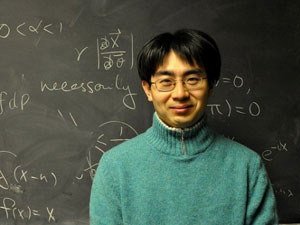Math professor uses mathematical models in his quest to better understand medical problems

Math may have caused plenty of headaches through history, but Yoichiro Mori has turned the tables. As a top researcher at the University of Minnesota, Mori is using mathematics in the quest to understand migraines, heart arrythmias, and other ailments.
Electricity is the way cells communicate with each other in the human body in order to think, synchronize the heartbeat, and move muscles, to name just a few functions. Mori’s goal is to model cells’ and tissues’ electrical activity in great detail. Because his models are foundational and so promising for basic biomedical research, he was named a McKnight Land-Grant Professor for 2010-12.
It’s no mystery why Mori applies mathematics to medical problems. Before he got a Ph.D., he earned an M.D. degree in Tokyo.
His combination of training and skills makes him an unusually versatile and valued researcher.
A major subject in Mori’s research is the way electricity passes between cardiac cells and affects the heartbeat. He has developed models that expand the understanding of heart disease in ways useful to other researchers. At the University of Minnesota, Mori continues to work with Alena Talkachova in the Department of Biomedical Engineering on projects related to cardiac arrythmias.
“Yoichiro’s thesis makes a dramatic advance in this extremely challenging modeling environment,” says Peter Olver, who heads the School of Mathematics. “The impact of his research is already being felt—he is working in direct collaboration with cardiologists and neuroscientists, with potential applications of his models to migraine headaches.”
Migraines have stumped researchers for decades. Mori has begun to examine ions in brain tissue because of their role in transmitting electrical signals. “Cortical spreading depression” is a disruption in the brain’s ions thought to be related to the visual auras that often signal sufferers that a migraine is about the begin. Because the concentration of ions fluctuates so dramatically, brain cell volume changes as water flows in and out.
Mori plans to study cortical spreading depression by including osmosis-induced water flow and cellular volume changes in his models. He’ll test several hypothetical mechanisms to see which could be responsible.
“The interplay between water flow and electrophysiology is a largely unexplored field in mathematical physiology,” says Mori. “Our study should open up exciting new areas where mathematics can play a significant role to explain physiological phenomena.”
Mori’s work enhances the University’s strengths in applied mathematics and numerical analysis and its efforts to build a world-class program in biomathematics, according to Olver.
So far, the McKnight professorship has allowed Mori to hire a graduate student who works on gel physics, aiming toward applications in biology. During the second year, Mori plans to visit colleagues in Chicago and Tokyo to advance some of his collaborations.
Growing up in Japan, Mori’s family steered him toward medical school. But he never gave up his true love—mathematics—reading dozens of advanced math books in his spare time, sailing through them with ease, according to one mentor. After his M.D. degree in 2002, he promptly went on for a Ph.D. in math.
Medicine has proven to be a field with plenty of challenges in need of Mori’s combination of knowledge and skills. And the University of Minnesota, with strength in science and medicine, is a good place to apply his talents.
